Are you struggling to keep guests comfortable at your tented events throughout the year? This guide offers practical tips for maintaining a cozy atmosphere in any weather. We’ll cover selecting the right tent types, implementing effective heating and cooling solutions, and optimizing your space and inventory. From managing logistics to choosing the perfect lighting, like lanterns, you’ll learn how to create memorable experiences for your guests, regardless of the season.
Key Takeaways
- Consider seasonal weather impacts when planning tented events to ensure guest comfort year-round
- Choose appropriate tent types and features for different seasons and events
- Implement effective heating and cooling solutions to maintain optimal temperatures inside tents
- Select comfortable furnishings and create clear pathways to enhance guest experience and accessibility
- Arrange seating for community interaction to foster a welcoming atmosphere at tented events
Understand Seasonal Weather Impacts on Tented Events
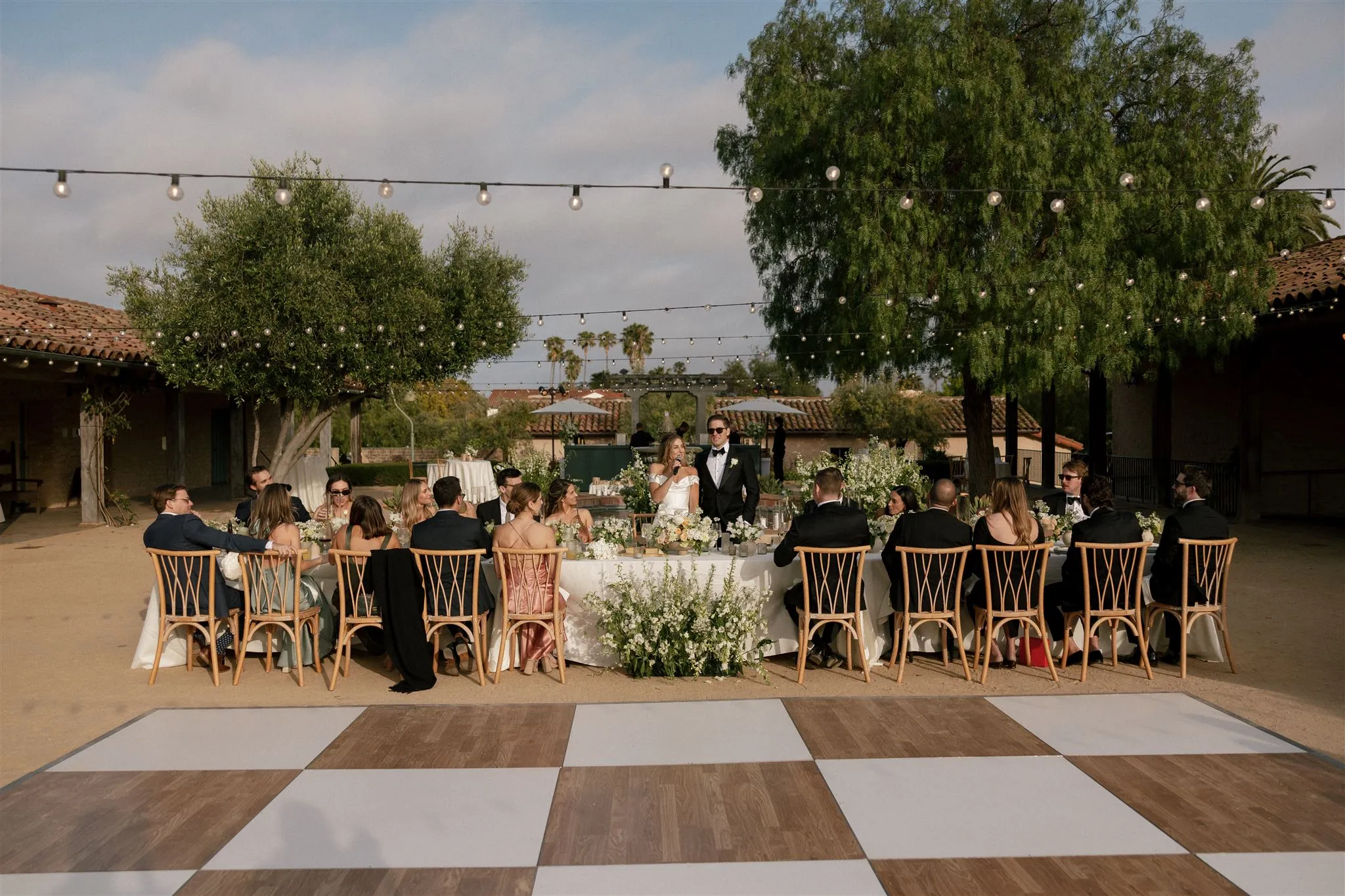
Understanding seasonal weather impacts is crucial for successful tented events. Event planners must assess temperature variations, anticipate precipitation challenges, and prepare for wind and storm conditions. These factors affect chair placement, budget considerations, tent selection, aesthetics, and ceiling design. By addressing these elements, organizers can ensure guest comfort year-round.
Assess Temperature Variations Throughout the Year
Temperature variations significantly impact tented events throughout the year. Event planners must consider the seasonal climate when selecting tent styles, furniture, and heating options. In colder months, propane heaters can warm the tent interior, while proper ventilation and cooling systems are essential for summer weddings. Choosing weather-appropriate furniture ensures guest comfort regardless of the season.
Anticipate Precipitation Challenges
Event planners must anticipate precipitation challenges to ensure guest comfort in tented events. Rain can affect tableware placement and kitchen operations, requiring proper ventilation to manage moisture. Insurance coverage for weather-related issues is crucial. Adequate drainage systems and waterproof flooring help maintain the tent’s beauty during wet conditions. Here’s a breakdown of precipitation considerations:
| Season | Precipitation Type | Mitigation Strategies |
|---|---|---|
| Spring | Rain showers | Covered walkways, umbrella stands |
| Summer | Thunderstorms | Lightning rods, backup generators |
| Fall | Light rain, early snow | Heated tent floors, weatherproof decor |
| Winter | Snow, sleet | Snow removal equipment, insulated walls |
Prepare for Wind and Storm Conditions
Event planners must prepare for wind and storm conditions to ensure guest safety and comfort in tented events. They should secure the tent structure with proper anchoring and choose sturdy materials that can withstand strong gusts. Waterproofing the tent floor and surrounding landscape helps maintain a dry atmosphere during rain. Installing wind-resistant walls and reinforcing weak points in the tent’s design can prevent damage and create a secure environment for guests.
Select Appropriate Tent Types for Comfort
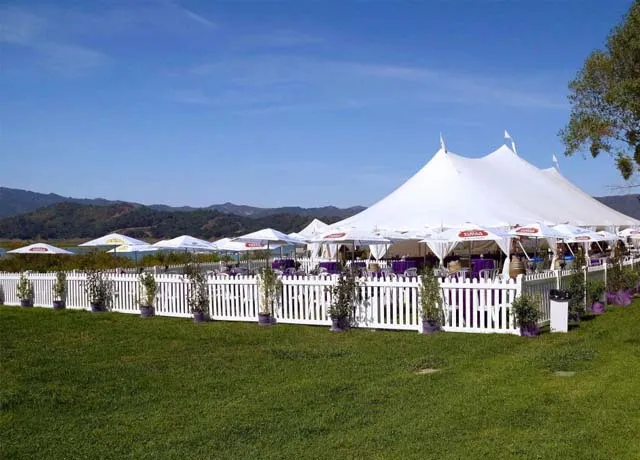
Selecting appropriate tent types is crucial for guest comfort at events year-round. Event planners must explore various tent styles, identify climate-responsive features, and evaluate insulation and ventilation options. These considerations impact entertainment, emergency preparedness, party atmosphere, linen selection, and overall design. Proper tent choice ensures a comfortable environment for guests in any season.
Explore Various Tent Styles for Different Events
Event planners must explore various tent styles to ensure guest comfort throughout the year. They need to consider factors like wind resistance and temperature control when selecting tents for birthday parties or dream weddings. Different tent types offer unique features suited for specific seasons and events:
| Tent Style | Best Season | Event Type | Key Features |
|---|---|---|---|
| Pole Tents | Spring/Summer | Outdoor Weddings | High peaks, open feel |
| Frame Tents | All Seasons | Corporate Events | Sturdy, customizable |
| Clear Span Tents | Fall/Winter | Galas | Enclosed, climate-controlled |
| Sailcloth Tents | Summer | Beach Parties | Lightweight, translucent |
Identify Climate-Responsive Features to Look For
Event planners should identify climate-responsive features when selecting tents for year-round comfort. Key elements include proper insulation, air conditioning systems, and weather-resistant materials. In mountain regions, tents with reinforced frames withstand strong winds, while breathable fabrics prevent condensation. Adequate flooring, such as raised platforms with carpet, protects guests from ground moisture and cold. These features ensure a comfortable environment for activities like dancing, regardless of external conditions.
Evaluate Insulation and Ventilation Options
Event planners must evaluate insulation and ventilation options when selecting tents for year-round comfort. They should choose tents with appropriate insulation materials to maintain optimal temperatures in cold weather and ensure proper ventilation systems for hot summer events. Adequate airflow prevents stuffiness and condensation, while insulated walls and floors help retain heat in colder months. By carefully considering these factors, planners can create a comfortable environment for guests regardless of the season.
Implement Effective Heating Solutions
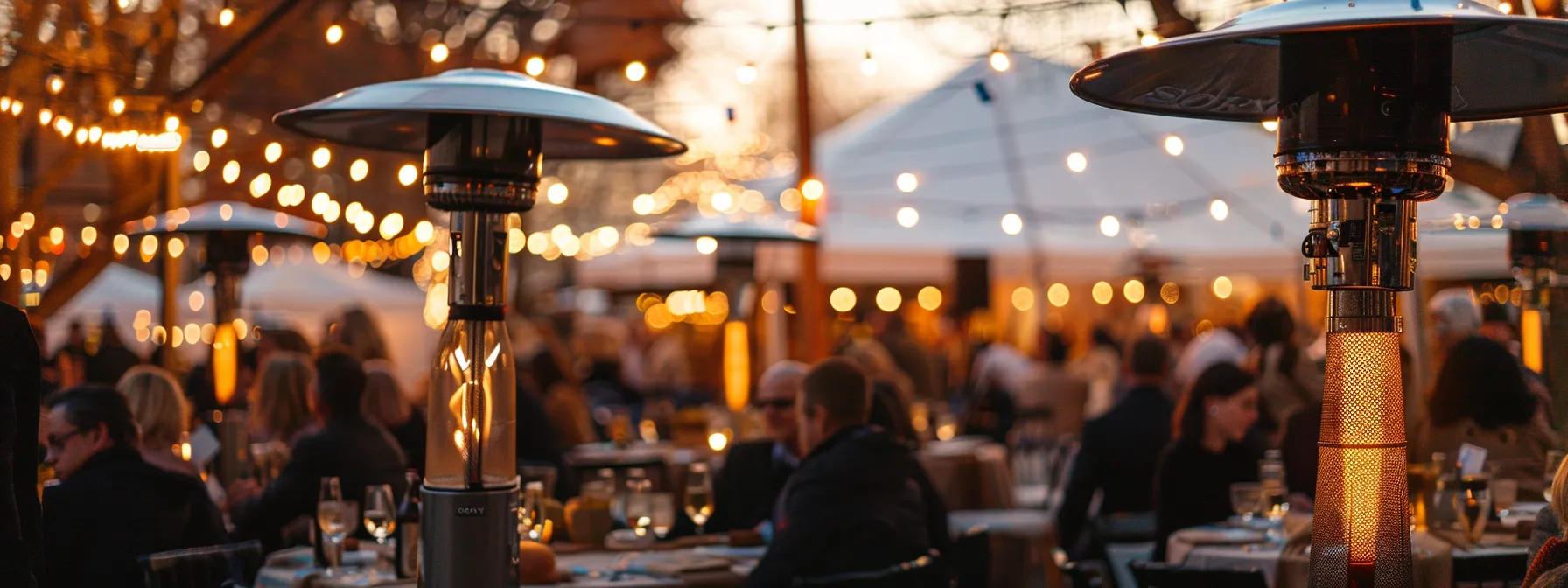
Implementing effective heating solutions is crucial for tented events in colder seasons. Event planners must research portable heating equipment, consider radiant and forced air heaters, and plan the layout for optimal heat distribution. These strategies ensure guest comfort and create a warm, inviting atmosphere regardless of outdoor temperatures.
Research Portable Heating Equipment
Event planners should research portable heating equipment to ensure guest comfort in tented events during colder seasons. They need to consider factors such as heat output, energy efficiency, and safety features when selecting heaters. Propane-powered patio heaters and electric infrared heaters are popular choices for their portability and effectiveness in outdoor settings. Planners must also factor in the tent size and expected guest count to determine the number of heating units required for optimal temperature control.
Consider Radiant and Forced Air Heaters
Event planners should consider both radiant and forced air heaters for tented events in colder seasons. Radiant heaters provide localized warmth and are ideal for smaller areas, while forced air heaters distribute heat evenly throughout larger spaces. When selecting heating options, planners must consider factors such as tent size, guest count, and power requirements. Here’s a comparison of radiant and forced air heaters:
- Radiant heaters: Direct heat, energy-efficient, silent operation
- Forced air heaters: Quick heating, wide coverage, adjustable temperature
- Combination: Use both types for optimal comfort in different tent zones
Plan Layout for Optimal Heat Distribution
Event planners must carefully plan the layout for optimal heat distribution in tented events during colder seasons. They should strategically place heaters around the perimeter and in high-traffic areas to ensure even warmth throughout the space. Proper placement of heating units, combined with the use of fans to circulate warm air, helps maintain a comfortable temperature for guests. Planners should also consider creating designated warm zones near food stations and seating areas to enhance guest comfort.
Optimize Cooling Techniques for Hot Weather
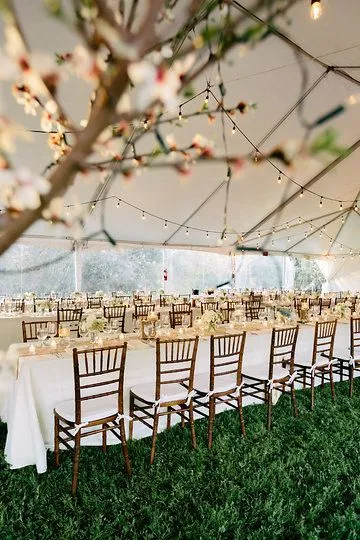
Optimizing cooling techniques is essential for hot weather tented events. Event planners can use shade structures to reduce heat, incorporate fans for air circulation, and ensure adequate ventilation design. These strategies help maintain guest comfort during warm seasons, creating a pleasant environment for outdoor gatherings.
Use Shade Structures to Reduce Heat
Event planners can use shade structures to reduce heat in tented events during hot weather. Strategically placed canopies, umbrellas, or awnings create shaded areas that lower temperatures and provide relief for guests. These structures block direct sunlight, preventing heat buildup inside the tent and creating comfortable zones for outdoor activities. Planners should consider the sun’s path throughout the day when positioning shade structures for maximum effectiveness:
| Time of Day | Sun Position | Recommended Shade Structure |
|---|---|---|
| Morning | East | Vertical screens or panels |
| Midday | Overhead | Overhead canopies or sail shades |
| Afternoon | West | Angled awnings or retractable shades |
| Evening | Low west | Portable umbrellas or pop-up tents |
Incorporate Fans and Air Circulation
Event planners can incorporate fans and air circulation systems to optimize cooling in tented events during hot weather. They should strategically place high-volume, low-speed fans throughout the tent to create a gentle breeze and improve air movement. Portable air conditioning units can be used in conjunction with fans to provide targeted cooling in specific areas. Planners should consider the tent size, guest count, and power requirements when selecting and positioning cooling equipment:
| Cooling Method | Tent Size | Effectiveness | Power Needs |
|---|---|---|---|
| Pedestal Fans | Small to Medium | Moderate | Low |
| Ceiling Fans | Medium to Large | Good | Medium |
| Misting Systems | Any Size | High | Low to Medium |
| Portable AC Units | Small to Medium | Very High | High |
Ensure Adequate Ventilation Design
Event planners should ensure adequate ventilation design for tented events in hot weather. Proper ventilation helps maintain air quality, reduces humidity, and enhances guest comfort. Planners can incorporate strategically placed vents, removable sidewalls, and mesh windows to promote natural airflow. These design elements work together to create a pleasant environment for attendees:
- High-peak tent designs for improved air circulation
- Cross-ventilation through opposite openings
- Raised flooring to allow air movement underneath
- Use of breathable fabric for tent walls
- Installation of exhaust fans to remove hot air
Furnish Comfortably for Guests
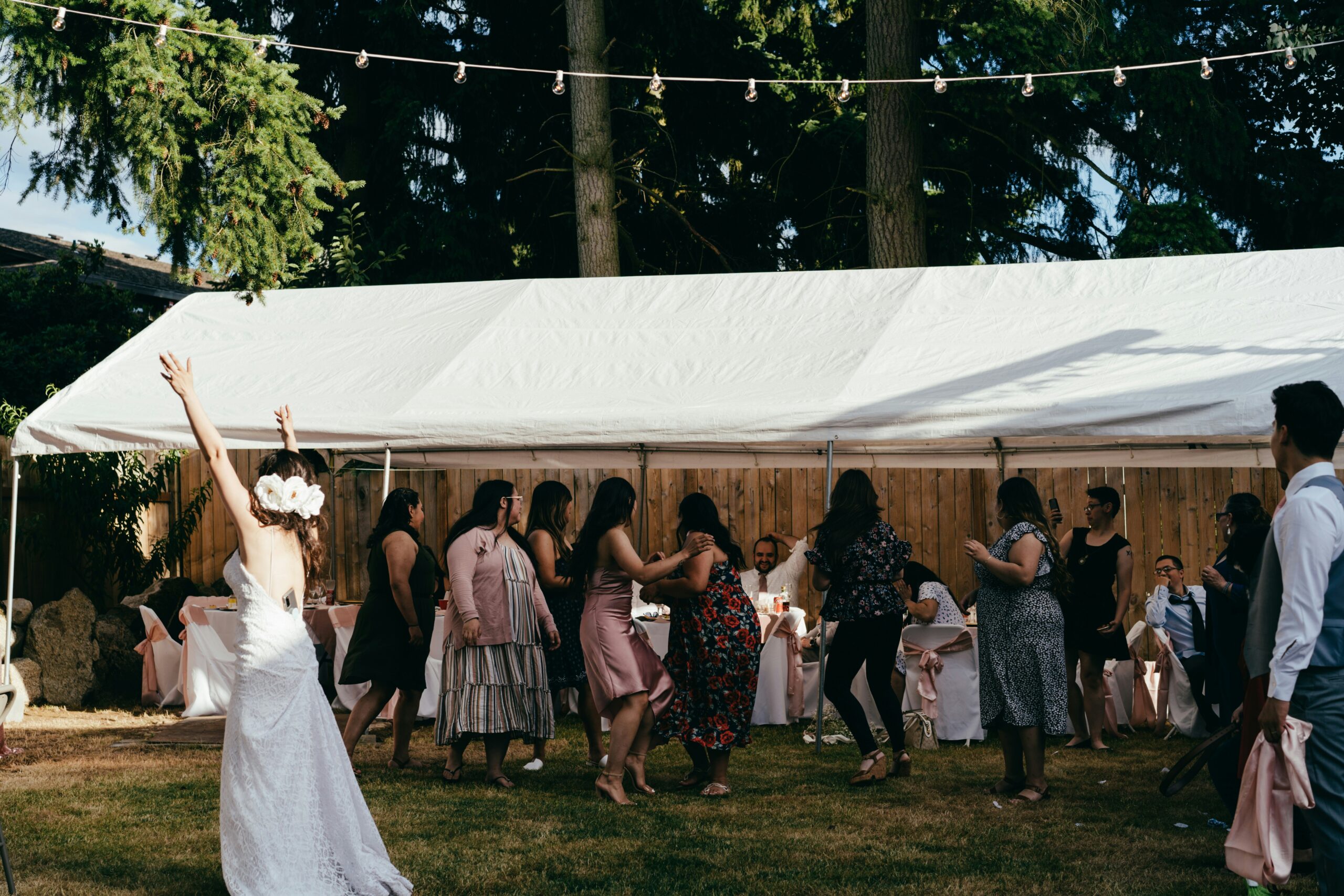
Furnishing tented events comfortably ensures guest satisfaction year-round. Event planners should choose appropriate seating options, provide adequate table space for activities, and incorporate relaxation elements. These considerations enhance the overall experience, allowing guests to enjoy the event regardless of weather conditions.
Choose Comfortable Seating Options
Event planners should select comfortable seating options to ensure guest satisfaction in tented events throughout the year. They must consider factors such as weather conditions, event duration, and guest demographics when choosing chairs and lounging furniture. Padded chairs with backs provide comfort for longer events, while weatherproof materials resist moisture and temperature changes. Planners can also offer a variety of seating styles to accommodate different preferences:
| Seating Type | Best For | Weather Suitability |
|---|---|---|
| Folding Chairs | Short Events | All Seasons |
| Chiavari Chairs | Formal Events | Indoor/Covered Areas |
| Adirondack Chairs | Outdoor Lounging | Spring/Summer |
| Heated Seats | Winter Events | Cold Weather |
Provide Adequate Table Space for Activities
Event planners must provide adequate table space for activities to ensure guest comfort in tented events throughout the year. When selecting table sizes and layouts, they should consider the event type, guest count, and planned activities. For dining events, planners can use round tables to promote conversation, while rectangular tables work well for buffet setups. Including cocktail tables or high-top tables creates additional space for mingling and casual interactions, enhancing the overall guest experience.
Incorporate Elements for Relaxation
Event planners can incorporate elements for relaxation to enhance guest comfort in tented events throughout the year. Soft lighting, such as string lights or lanterns, creates a cozy atmosphere. Comfortable lounge areas with plush seating and throw pillows provide spaces for guests to unwind. Adding ambient music and natural elements like potted plants or water features contributes to a relaxing environment, regardless of the season.
Plan for Accessibility and Mobility
Planning for accessibility and mobility is essential for tented events year-round. Event organizers must ensure clear pathways for movement, incorporate handicapped accessible features, and arrange seating for community interaction. These considerations enhance guest comfort and inclusivity, allowing all attendees to fully participate in the event regardless of physical abilities or weather conditions.
Ensure Clear Pathways for Movement
Event planners must ensure clear pathways for movement in tented events to enhance accessibility and comfort for all guests. They should design wide, obstacle-free walkways between seating areas, food stations, and amenities. Proper flooring materials, such as durable carpeting or interlocking tiles, provide stable surfaces for easy navigation. Adequate lighting along pathways improves visibility and safety, especially during evening events. Planners should consider the following elements when creating clear pathways:
- Minimum aisle width of 36 inches for wheelchair accessibility
- Non-slip surfaces to prevent accidents in wet conditions
- Strategically placed signage for easy navigation
- Ramps or level thresholds at tent entrances and exits
- Designated areas for mobility device parking
Incorporate Handicapped Accessible Features
Event planners must incorporate handicapped accessible features to ensure inclusivity in tented events year-round. They should install ramps with proper gradients at entrances and exits, providing easy access for wheelchair users. Accessible restrooms with grab bars and sufficient space for maneuverability are essential. Planners can also include lowered serving stations and tables to accommodate guests with mobility challenges, ensuring everyone can participate comfortably in the event.
Arrange Seating for Community Interaction
Event planners should arrange seating for community interaction to foster a welcoming atmosphere in tented events. They can create conversational groupings with chairs and tables positioned in semicircles or clusters, encouraging guests to engage with one another. Incorporating a mix of seating options, such as high-top tables and lounge areas, allows attendees to choose their preferred social setting. This thoughtful arrangement promotes inclusivity and enhances the overall event experience for all guests.
Conclusion
Ensuring comfort in tented events throughout the year requires careful planning and attention to seasonal challenges. Event planners must select appropriate tent types, implement effective heating and cooling solutions, and furnish spaces comfortably to create an inviting atmosphere for guests. Accessibility and mobility considerations are crucial for inclusive events, while addressing weather impacts such as temperature variations, precipitation, and wind conditions is essential for success. By focusing on these key aspects, event organizers can create memorable experiences that keep guests comfortable and engaged, regardless of the season or weather conditions.






